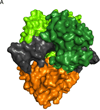Structure and function of the DNA ligases encoded by the mammalian LIG3 gene
- PMID: 24013086
- PMCID: PMC3881560
- DOI: 10.1016/j.gene.2013.08.061
Structure and function of the DNA ligases encoded by the mammalian LIG3 gene
Abstract
Among the mammalian genes encoding DNA ligases (LIG), the LIG3 gene is unique in that it encodes multiple DNA ligase polypeptides with different cellular functions. Notably, this nuclear gene encodes the only mitochondrial DNA ligase and so is essential for this organelle. In the nucleus, there is significant functional redundancy between DNA ligase IIIα and DNA ligase I in excision repair. In addition, DNA ligase IIIα is essential for DNA replication in the absence of the replicative DNA ligase, DNA ligase I. DNA ligase IIIα is a component of an alternative non-homologous end joining (NHEJ) pathway for DNA double-strand break (DSB) repair that is more active when the major DNA ligase IV-dependent pathway is defective. Unlike its other nuclear functions, the role of DNA ligase IIIα in alternative NHEJ is independent of its nuclear partner protein, X-ray repair cross-complementing protein 1 (XRCC1). DNA ligase IIIα is frequently overexpressed in cancer cells, acting as a biomarker for increased dependence upon alternative NHEJ for DSB repair and it is a promising novel therapeutic target.
Keywords: BRCT; Cancer; DBD; DNA PK; DNA binding domain; DNA double-strand break; DNA ligase encoding gene; DNA ligases; DNA single-strand break; DNA-dependent protein kinase; DSB; LIG; LIG3; MLS; Mitochondria; NEIL; NHEJ; NLS; NTase; Nei endonoclease VIII-like protein; Neurodegeneration; Nuclear DNA repair; OBD; PARP1; PNKP; SSB; Tdp1; X-ray cross-complementing protein 1; XRCC1; ZnF; breast cancer susceptibility protein 1-related C-terminal; mitochondrial leader sequence; non-homologous end joining; nuclear localization signal; nucleotidyl transferase domain; oligonucleotide/oligosaccharide-fold binding domain; poly(ADP-ribose) polymerase 1; polynucleotide kinase phosphatase; tyrosyl phosphodiesterase 1; zinc finger.
© 2013 Elsevier B.V. All rights reserved.
Figures







References
-
- Ahel I, Rass U, El-Khamisy SF, Katyal S, Clements PM, McKinnon PJ, Caldecott KW, West SC. The neurodegenerative disease protein aprataxin resolves abortive DNA ligation intermediates. Nature. 2006;443:713–716. - PubMed
-
- Ame J, Spenlehauer C, de Murcia G. The PARP superfamily. Bioessays. 2004;26:882–893. - PubMed
-
- Barnes DE, Tomkinson AE, Lehmann AR, Webster AD, Lindahl T. Mutations in the DNA ligase I gene of an individual with immunodeficiencies and cellular hypersensitivity to DNA-damaging agents. Cell. 1992;69:495–503. - PubMed
-
- Barzilai A. The contribution of the DNA damage response to neuronal viability. Antioxid Redox Signal. 2007;9:211–218. - PubMed
Publication types
MeSH terms
Substances
Grants and funding
LinkOut - more resources
Full Text Sources
Other Literature Sources
Research Materials
Miscellaneous

